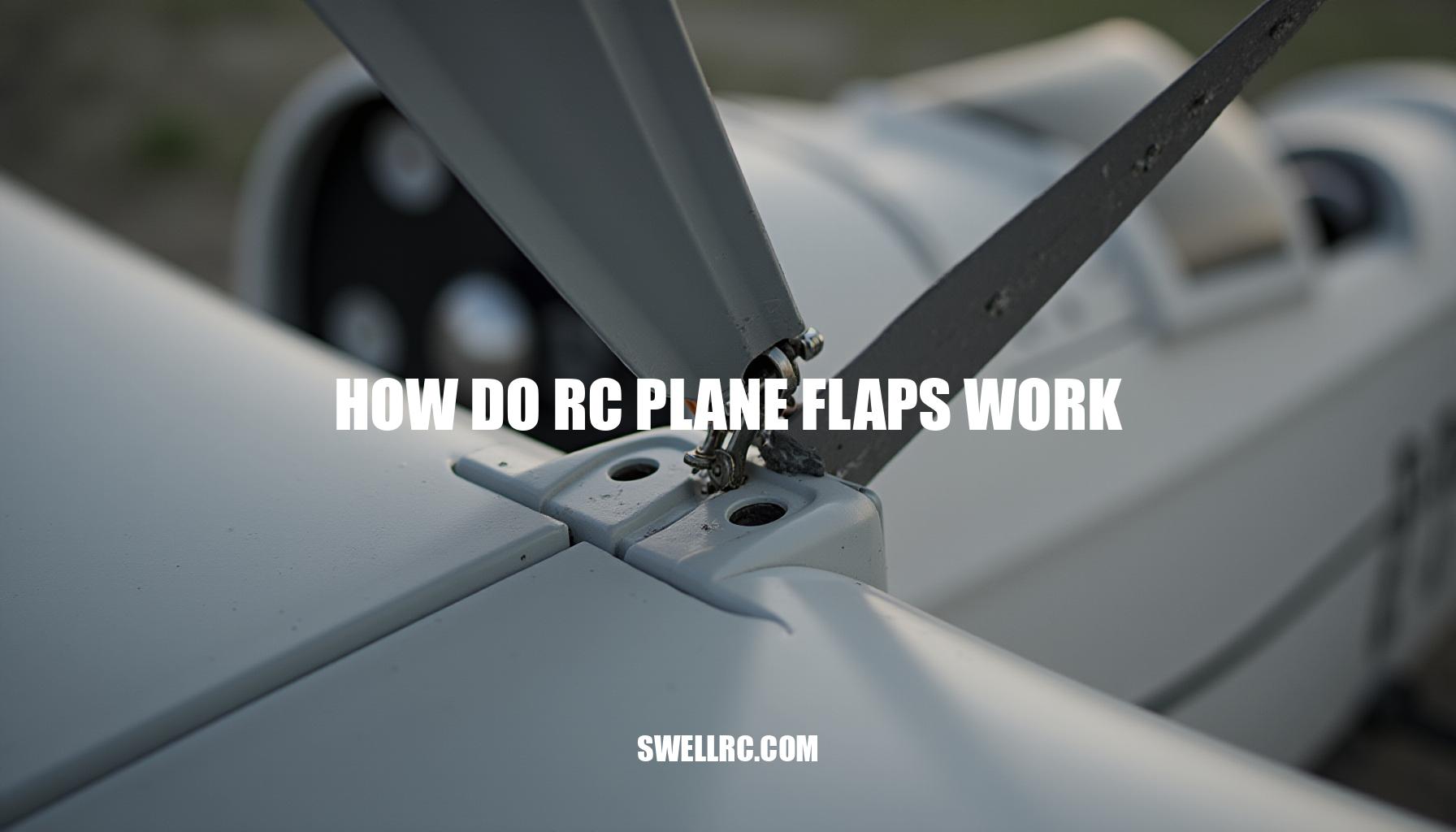How Do RC Plane Flaps Work: Mastering Aerodynamics for Controlled Flight
My first real flirtation with flaps was a sunset landing that went sideways—literally. I bumped the switch, the wing pitched up, the plane ballooned, and I thought I’d botched it. But when I eased in a touch of throttle and held the line, the landing rolled out smoother than any I’d done.
That was the night I got hooked. In simple terms, flaps are hinged panels on the trailing edge of the wing that swing down to change the wing’s shape. They boost lift at low speeds and add drag to help you slow down, transforming how we handle takeoff, approach, and short-field landings.
Understanding flap mechanics is key to mastering RC plane aerodynamics and controlling flight. As essential flight control surfaces, flaps are among the most impactful RC aircraft parts that affect both lift and drag in RC planes. From plain to split and Fowler types, knowing the various RC plane flaps types empowers you to switch between fast-and-loose flying and precise, confident control.
If you’re new to the bigger picture of airframes, radios, and power systems, this primer on how an RC plane works is a perfect companion. Let’s dive into what flaps actually do in the air and elevate your RC flying skills to the next level.
The Engineering Behind RC Plane Flaps
When flaps extend downward on an RC plane, they significantly increase the wing’s camber. This change in shape allows the wing to generate more lift at a given angle of attack, enabling slower flight speeds without stalling. Understanding RC plane aerodynamics is key here, as the flaps directly influence how much lift and drag your model produces.
The primary effect of flaps is twofold:
- Increased lift: More camber means more lift, which is especially useful for slow flight and stall control. This allows for safer landings and better control during low-speed maneuvers.
- Increased drag: While additional drag might sound undesirable, it plays an important role in enabling steep, controlled descents and shorter rollouts after landing.
From an aerodynamic perspective, extending flaps shifts the pressure distribution along the wing, often moving the center of pressure either aft or forward depending on the flap type. This shift can cause the model to pitch, which is why many pilots apply elevator compensation to maintain steady flight. Even small adjustments matter greatly; a slight RC flap angle adjustment of just a few degrees can reduce approach speed without sacrificing wing stability.
Your RC plane’s radio mixing and endpoint settings determine how precisely you can tune flap deflection. If you’re interested in the technical side of how your transmitter’s sticks translate into servo movements, this detailed overview of radio links and protocols is an excellent resource.
Think of flaps not as adding power to your plane but as invaluable tools that enhance your wing’s cooperation during crucial low-speed moments. Mastering the effects of flaps on lift and drag and how to adjust them will elevate your flying experience and provide much better control in critical phases such as landing and tight turns.
Flap Angle Effects: Quick Reference
Understanding the impact of RC flap angle adjustment is crucial for optimizing lift and drag in RC planes. The flap angle directly influences the aerodynamic properties during flight phases such as takeoff, cruising, and landing. The following table illustrates how different flap angles affect lift and drag, helping you fine-tune your RC takeoff and landing settings for better performance:
| Flap Angle | Lift Effect | Drag Effect | Recommended Use |
|---|---|---|---|
| 0° | Neutral | Low | Cruise flight |
| 10–20° | Moderate lift | Low–moderate drag | Shorter takeoff, slow flight practice |
| 30–40° | High lift | High drag | Controlled approaches and landing |
It’s important to note that the exact behavior of lift and drag depends on multiple factors including wing design, center of gravity (CG), and flap type (plain, split, slotted, Fowler). Always perform incremental testing when adjusting flap angles to achieve the optimal balance between lift and drag for your specific RC aircraft.
Flaps vs Ailerons – Knowing Your Control Surfaces
Ailerons and flaps, both crucial flight control surfaces, reside on the trailing edge of wings but serve distinctly different functions. The key difference in aileron vs flaps lies in their movements and effects: ailerons work in opposite directions to roll or bank the aircraft, enabling precise steering, while flaps move together to increase lift and drag, aiding in slower, more stable flight.
Some aircraft models feature flaperons, combining ailerons and flaps where the ailerons also drop like flaps. This design is particularly handy on simple wings but may reduce roll authority at high deflection angles, a tradeoff to consider during setup.
Choosing the right servo is critical for both torque and precise centering, especially when setting up these control surfaces. For expert advice on servo setup for flaps and ensuring optimal performance matched to your airframe, visit this comprehensive guide.
| Control Surface | Movement | Primary Function |
|---|---|---|
| Ailerons | Opposite directions | Roll and steer aircraft |
| Flaps | Together | Increase lift and drag |
| Flaperons | Together and differential | Combination of roll and lift/drag increase |
When selecting RC plane flaps types, consider your flight style. Sport and trainer planes often benefit from simple flaps to build pilot confidence during pattern flying, whereas scale or mission-driven models, such as cargo or novelty-drop planes, prioritize slow, stable passes to match their functional needs. For inspiration and ideas, check out this resource on specialized mission builds.
- Ailerons: Steer and roll the plane.
- Flaps: Modify wing shape to control lift and drag.
- Flaperons: Hybrid controls balancing roll and lift benefits.
- Servo choice: Match torque and centering precision to your setup.
- Flight style: Influences flap type and control configuration.
Big takeaway: ailerons steer, flaps reshape the wing. Understanding both enhances your flying skills instantly and ensures your RC aircraft performs at its best.
Flaps vs Ailerons: Quick Differences
Understanding the differences between aileron vs flaps is crucial when examining flight control surfaces and their effects on aircraft performance, especially regarding slow flight and stall control. Here are the primary distinctions:
- Ailerons: move in opposite directions to create roll with minimal drag change at neutral settings.
- Flaps: move in the same direction to increase both lift and drag, enabling slower flight.
- Flaperons: function as ailerons but also drop downward to enhance low-speed lift, though this can slightly soften roll response.
As a setup note, maintaining adequate aileron authority when using flaperons is important; this can be achieved by limiting flap deflection or utilizing specific flight modes to balance control effectiveness and safety during slow flight and stall recovery maneuvers.
How to Set Up and Adjust RC Plane Flaps Correctly: Tools and Checklist
When preparing an RC aircraft for flight, ensuring a precise servo setup for flaps is crucial for optimal control and performance. The process typically involves working with two flap surfaces, or sometimes a single-piece design depending on the wing configuration. Proper installation includes aligning hinges and control horns accurately to guarantee smooth movement.
Using linkages or pushrods with minimal slop helps maintain responsiveness and prevents unwanted play in the system. Dedicated flap servos are preferred, although sharing servos via Y-connectors may be suitable in certain scenarios, provided there are enough available channels on the radio system. Modern radios often feature mixes or flight modes to manage flap deployment efficiently.
Additionally, having a power system with sufficient headroom for go-around thrust is essential for safety during critical flight phases. For safe testing, utilizing a ground stand or enlisting a helper is recommended to prevent accidents. Understanding the different RC plane flaps types is also beneficial when choosing the appropriate RC aircraft parts and setting up the control system.
Step-by-Step Flap Tuning for Real Results
When learning how to set up flaps on RC plane, it’s important to follow a systematic approach to ensure optimal performance and safety. Begin by defining your deflection goals, typically starting with 12–15° for takeoff and increasing to 25–35° for landing. Next, proceed with the servo setup for flaps by assigning a switch or slider and configuring the endpoints.
It’s also beneficial to add a 0–10% elevator mix to counteract any pitch changes induced by flap deployment. To provide a clear guide, follow these steps:
- Define deflection goals: 12–15° for takeoff, 25–35° for landing.
- Assign controls and set servo endpoints; add 0–10% elevator mix.
- Bench-test flap deployment for symmetry and ensure linkages do not bind at full throw.
- Perform maiden flight at altitude, deploy takeoff flaps, observe pitch changes, and fine-tune elevator mix in 1–2% increments.
- Practice landing using approach flaps, maintain stability with light throttle, and adjust mix and idle settings as needed.
- Add light stabilization if available; compact gyros can significantly smooth gust bumps during flap transitions (RC plane gyro).
Throughout this process, monitor slow flight and stall control carefully since excessive flap deflection may blank the tail or induce a tip stall. Thus, approach your RC flap angle adjustment incrementally, maintaining a safe airspeed margin during early tests.
This methodical procedure ensures your flaps operate efficiently while enhancing overall flight stability and control.
Real Flight Impact – What Happens When You Deploy Flaps
After hours of trial flights, here’s what consistently stood out about the effects of flaps on lift and drag. The moment I drop approach flaps, the airplane settles into a slower, more stable attitude; throttle becomes my glidepath control while pitch sets speed. Many planes pitch up with flap extension, so I pre-trim a touch of down elevator or use a mix to maintain control.
Power-off descents steepen cleanly with full flaps because drag goes way up, which is gold on short fields. In gusty days, flaps can help you fly slower without flirting with a stall, but use them smartly with proper crosswind technique—this windy-day primer is excellent for mastering such conditions.
Managing approach energy is half the game; understanding RC plane speed management adds vital context to how throttle and prop settings affect your flight path. Check out this overview on speed management for deeper insights.
Not every airframe uses classic flaps—flying wings, for example, often rely on elevon mixing and techniques like crow or reflex for similar low-speed control. If you’re interested in slow flight and stall control techniques for such models, here’s a deeper look into flying wings.
| Flight Aspect | Recommended Settings | Benefits |
|---|---|---|
| Approach Flaps | Light to full flap depending on airframe | Increased lift and drag to control descent angle and speed |
| Throttle as Glidepath Control | Adjust throttle to manage sink rate | Maintains stable glidepath during approach |
| Pitch for Speed | Fine-tune pitch to maintain desired airspeed | Prevents stalls and keeps flight smooth |
| Crosswind Technique with Flaps | Use flaps cautiously with proper rudder input | Enhances control in gusty conditions without stalling |
Optimal RC takeoff and landing settings depend on your specific plane, but understanding and leveraging the effects of flaps on lift and drag in conjunction with speed and energy management is key to smoother, safer flights.
Before vs After Flap Deployment: Field Data Snapshot
Understanding the RC plane speed during various flight conditions is crucial for effective slow flight and stall control. The table below outlines typical speed and behavior settings for different flap configurations, which are essential for optimizing RC takeoff and landing settings:
| Scenario | Clean (0°) | Takeoff Flaps (~15°) | Landing Flaps (~30–35°) |
|---|---|---|---|
| Stall speed (indicative) | 24 mph | 21 mph | 19 mph |
| Approach speed | 28–30 mph | 25–26 mph | 22–24 mph |
| Landing distance | 100% baseline | 85–90% | 65–75% |
| Pitch behavior | Neutral | Slight pitch-up | Noticeable pitch-up (mix needed) |
These numbers are illustrative; always verify values on your specific airframe and environmental conditions to ensure precise control and safety during flight operations.
Advanced Flap Configurations and Innovations
Curious to push further in enhancing your RC aircraft’s performance? Builders often experiment with various RC plane flaps types such as split and slotted flaps to achieve bigger lift boosts. Additionally, Fowler flaps, which slide back and down to increase both wing area and camber, are popular choices for boosting slow flight capabilities.
Electronic innovations contribute significantly as well; advanced flight modes can sequence partial-to-full flap deployment paired with timed elevator compensation to maintain smooth control. Crow braking—deploying flaps down while raising ailerons—is especially useful on gliders to spike drag without causing ballooning, providing refined stall control.
When working on lightweight projects, it’s essential to perform careful tradeoffs. Extra mechanical components can add grams quickly, so prioritizing weight savings where it matters most is key. For guidance, check out these ultralight build tips tailored to optimize RC aircraft parts while keeping the craft light: Ultralight RC Indoor Plane Tips.
Don’t overlook the importance of propeller and airframe harmony. While flaps allow you to fly slower and improve control during slow flight, the propeller efficiency must still be optimized to bite effectively at these reduced airspeeds. This comprehensive prop selection guide pairs perfectly with flap adjustments, ensuring your powertrain performs efficiently across all flight modes.
Choosing between mechanical linkages and independent servos for flap control presents another design fork. Mechanical linkages save weight and reduce complexity, while independent servos offer precision and flexible mixing capabilities. Regardless of approach, the goal remains the same—fine-tuning the wing’s flap angles for graceful, predictable low-speed handling.
| RC Plane Flap Types | Function | Benefits |
|---|---|---|
| Split Flaps | Flap lowers from wing’s lower surface | Increased lift and drag; effective for slow flight |
| Slotted Flaps | Gap between flap and wing allows high-pressure air to flow | Better lift increase without excessive drag |
| Fowler Flaps | Slide backward and downward, increasing wing area & camber | Significant lift boost, ideal for slow flight and stall control |
Conclusion: Mastering the Art of Controlled Flight
After all the testing and tweaks, what I learned blew my mind: flaps aren’t just for landings—they’re a language your wing speaks at low speed. Use them thoughtfully and your RC takeoff and landing settings improve dramatically. Your takeoffs shorten, your approaches calm down, and your touchdowns look like they belong on rails.
Start with modest deflections, test high, mix small, and add complexity only as you earn it.
Understanding RC plane aerodynamics is key to mastering slow flight and stall control. Using flight control surfaces like flaps effectively gives you an advantage in managing these delicate phases of flight.
Keep exploring the systems that support precision:
- Radios for accurate input
- Servos for responsive control surface movement
- Gyros that stabilize your plane
- Props optimized for thrust
- Airframes designed for aerodynamic efficiency
By integrating knowledge of slow flight and stall control with precise management of your flight control surfaces, your RC flying will feel more connected, more intentional, and a lot more fun.
Frequently Asked Questions
- What is the purpose of flaps on an RC plane?
Flaps increase wing camber to generate more lift at lower speeds and add drag to help slow the aircraft, making takeoffs shorter and landings slower and more controlled. - How do flaps affect lift and drag in RC aircraft?
Deploying flaps boosts lift by increasing camber, which lowers stall speed, but it also increases drag. This combo enables slower, steeper, and more stable approaches. - When should flaps be deployed during takeoff or landing?
Use 10–20° for short or soft-field takeoffs to lift off sooner and 25–35° for approach and landing to reduce speed and distance. Always adjust by airframe and test gradually. - What’s the difference between flaps and ailerons on an RC plane?
Ailerons work opposite each other to roll the airplane; flaps move together to increase lift and drag. Flaperons combine roles but may reduce roll authority at high deflection. - How do you set up servos for RC plane flaps?
Use adequately torqued servos with solid linkages, assign a dedicated channel or mix, set endpoints for 12–15° (takeoff) and 25–35° (landing), and add elevator compensation via mixes. Bench-test and flight-tune in small steps. - Can flaps damage flight stability if used incorrectly?
Yes. Excessive deflection can cause strong pitch changes, blank tail surfaces, or induce tip stalls. Introduce flap angles gradually, maintain speed margins, and use elevator compensation. - How much flap deflection should an RC plane have?
Typical starting points are 12–15° for takeoff and 25–35° for landing. Fine-tune based on wing design, CG, and how the airplane pitches with flap deployment. - Do larger RC planes benefit more from flaps than smaller ones?
Generally yes. Larger and heavier models see more pronounced benefits in reduced stall speed and landing distance, though even small trainers gain stability and confidence during approach.



